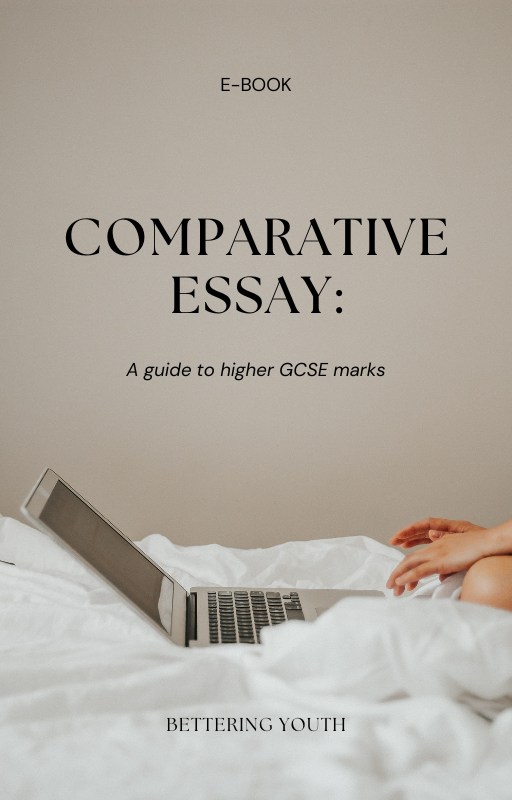Want to craft a stellar comparative essay? Let’s learn about the structure of Comparative essays.
Essay structure is a crucial skill for achieving those coveted grades 8-9 in GCSE English. At Bettering Youth, we believe in nurturing academic excellence while prioritizing the well-being of our students. Let’s explore the structure, key elements, and impactful vocabulary to elevate your child’s comparative essay writing.
Understanding Comparative Essays
A comparative essay involves analyzing and comparing two or more texts to uncover meaningful connections, contrasts, and insights. It goes beyond summarizing; it delves into the nuances of literary elements, themes, and characters across different works. Understanding how to structure this essay is important to ensure maximum impact for the reader.
How to Structure a Comparison Essay
Introduction
The introduction sets the stage for your essay. Begin with a compelling hook that intrigues the reader, followed by a concise thesis statement outlining the texts you’ll be comparing and your main argument. Make sure your readers know which texts you’ll be comparing.
Tip: A thought-provoking quote or a bold statement can make for a captivating introduction.
Body Paragraphs
1. Point of Comparison
– Introduce the first aspect you’ll be comparing.
– Provide context and mention the texts.
2. Analysis of Text 1
– Dive into the first text, exploring relevant quotes and examples.
– Analyze literary devices, themes, and characters.
3. Analysis of Text 2
– Apply the same detailed analysis to the second text.
– Draw comparisons and contrasts with Text 1.
4. Comparative Analysis
– Explore the similarities and differences between the texts.
– Use comparative phrases to enhance clarity.
Tip: “Similarly,” “Likewise,” and “Conversely” are powerful connectors for comparative analysis.
Conclusion
Summarize the key points without introducing new information. Reinforce your thesis and leave a lasting impression on the reader.
Tip: End with a thought-provoking statement that resonates with your analysis.

GCSE English February course
Two Types of Comparative Essay Structure
1. Block Method
– Structure:
– Separate sections for each text.
– Advantages:
– Clear and straightforward.
– Easy to follow.
– Considerations:
– May lead to a list-like essay.
2. Integrated Method
– Structure:
– Alternating points between texts.
– Advantages:
– Promotes direct comparison.
– Highlights connections.
– Considerations:
– Requires a strong organizational skill.
Achieving Grade 8-9: Key Elements
1. Sophisticated Vocabulary
– Replace common words with more nuanced alternatives.
– Utilize a thesaurus to enrich your vocabulary.
Tip: Instead of “show,” consider “illustrate” or “demonstrate.”
2. Varied Sentence Structure
– Experiment with sentence length and structure.
– Incorporate complex sentences for depth.
Tip: Combine short, punchy sentences with longer, more elaborate ones for a dynamic flow.
3. Critical Analysis
– Go beyond surface-level analysis.
– Interpret the author’s intentions and the impact on the reader.
Tip: Address the “how” and “why” of literary techniques and their effect.
4. Clear Comparative Phrasing
– Use explicit comparative phrases.
– Ensure a seamless flow between texts.
Tip: “In contrast to,” “By comparison,” and “On the contrary” enhance the clarity of your comparisons.
Join the Bettering Youth Community Today!
If you’re seeking a GCSE English tutor who understands the delicate balance between academic success and well-being, Bettering Youth is here for you. Join our community, and together, let’s embark on a journey towards Bettering Youth.
Mastering the Art of Essays:
- part 1: preparing for your comparative essay
- Part 2: understanding command words
- Mastering the Art of Essay Writing: A Comprehensive Guide
Comparative Essay Ebook Planner:

Download our Free Comprehensive Guide to Comparative Essays and boost your English GCSE Marks
References:
– Smith, J., “Mastering the Art of Comparative Essays” (2021), Academic Publishers.
– Turner, R., “A Guide to Advanced English Vocabulary” (2019), Scholarly Press.
